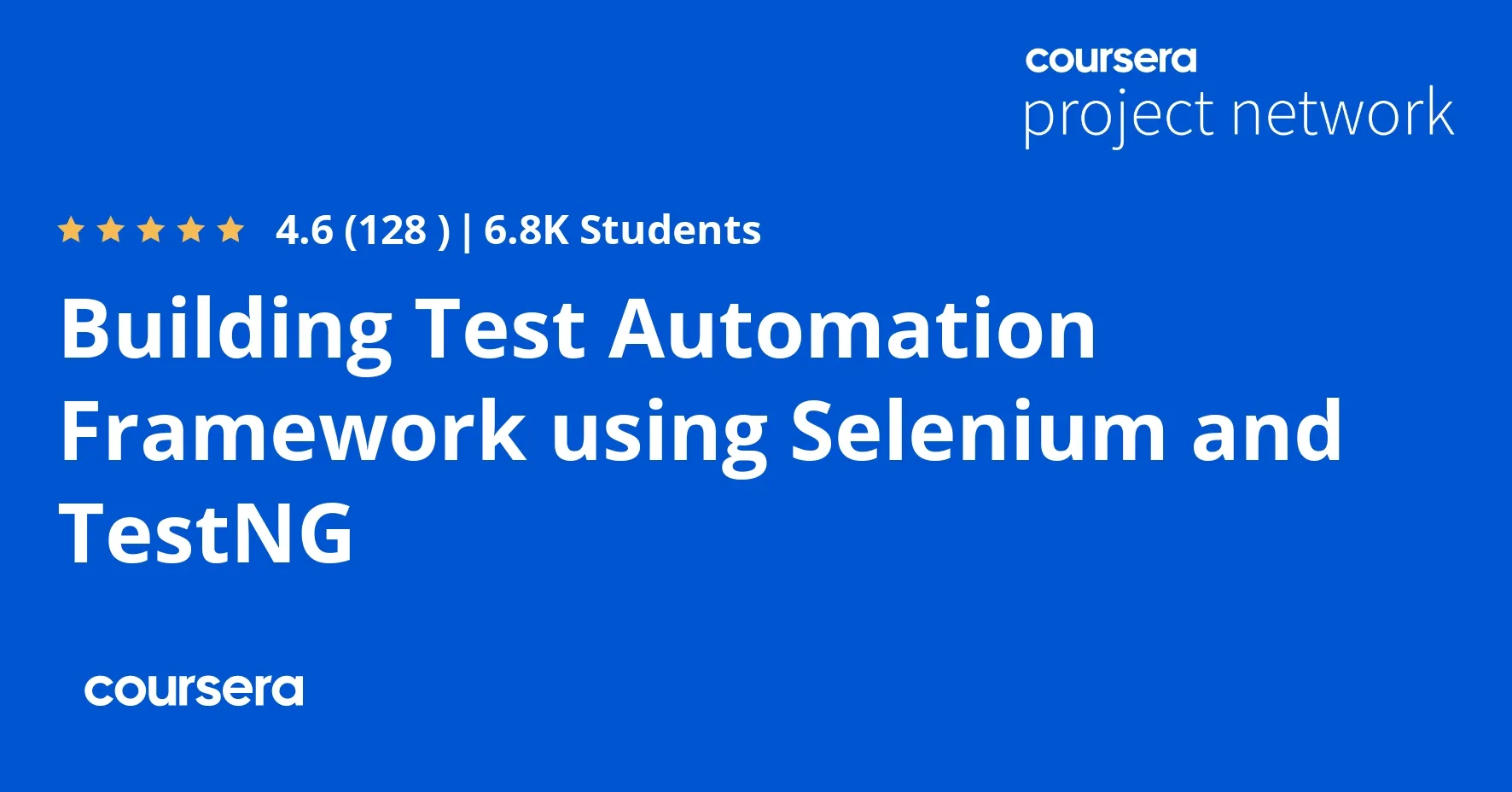
Building Test Automation Framework using Selenium and TestNG 
Get a comprehesive understanding of Building Test Automation Framework using Selenium and TestNG. This is a free course from Udemy. AZ Class provides this course data for free. Learn more certificate and details here. Learn how to build a powerful and efficient Test Automation Framework using Selenium and TestNG with this comprehensive online course. In this course, you will gain a deep understanding of creating a directory structure and setting up the framework. You will also learn how to create an automation layer and generic methods for browser invocation and URL navigation. Additionally, you will discover how to design an application layer using POM or Page Factory, write test cases, execute them using a TestNG XML file, and generate logs and reports with the Extent report. Don't miss this opportunity to enhance your test automation skills. Enroll now! ▼
ADVERTISEMENT
Course Feature
![]() Cost:
Cost:
Free
![]() Provider:
Provider:
Udemy
![]() Certificate:
Certificate:
No Information
![]() Language:
Language:
English
Course Overview
❗The content presented here is sourced directly from Udemy platform. For comprehensive course details, including enrollment information, simply click on the 'Go to class' link on our website.
Updated in [October 07th, 2023]
What does this course tell?
(Please note that the following overview content is from the original platform)
Creating a directory structure and understanding the Test Automation Framework
Creating an automation layer and a generic method for invoking a browser and navigating to a URL
Wrapper methods are used to perform user actions
Designing an application layer with POM or Page Factory
Logic is being added to the application layer
In the test layer write test cases
Using a TestNG XML file to execute test cases
Configuration is read from configproperties
Creating logs and reports with the Extent report
Attaching screenshots to failed test cases in the report
We considered the value of this course from many aspects, and finally summarized it for you from two aspects: skills and knowledge, and the people who benefit from it:
(Please note that our content is optimized through artificial intelligence tools and carefully reviewed by our editorial staff.)
What skills and knowledge will you acquire during this course?
During this course, the learner will acquire the following skills and knowledge:
1. Creating a directory structure and understanding the Test Automation Framework: The learner will learn how to organize the project files and folders in a structured manner to build a robust test automation framework.
2. Creating an automation layer and a generic method for invoking a browser and navigating to a URL: The learner will understand how to write code to automate the process of launching a browser and navigating to a specific URL.
3. Using wrapper methods to perform user actions: The learner will learn how to create wrapper methods that encapsulate common user actions such as clicking buttons, entering text, selecting options, etc., making the test code more readable and maintainable.
4. Designing an application layer with POM or Page Factory: The learner will understand the concept of Page Object Model (POM) or Page Factory and how to design the application layer to represent the different pages or components of the application under test.
5. Adding logic to the application layer: The learner will learn how to add logic to the application layer to perform various operations on the application, such as submitting forms, validating data, etc.
6. Writing test cases in the test layer: The learner will acquire the skill of writing test cases using TestNG, a popular testing framework, to define the test scenarios and expected outcomes.
7. Using a TestNG XML file to execute test cases: The learner will understand how to configure and use a TestNG XML file to define the test suite, specify the test classes and methods to be executed, and control the test execution flow.
8. Reading configuration from configproperties: The learner will learn how to read configuration settings, such as browser type, URL, credentials, etc., from a configuration file (e.g., config.properties) to make the test code more flexible and reusable.
9. Creating logs and reports with the Extent report: The learner will acquire the skill of generating logs and reports using the Extent report library, which provides detailed information about the test execution, including test status, steps, screenshots, etc.
10. Attaching screenshots to failed test cases in the report: The learner will learn how to capture screenshots during test execution and attach them to the report for failed test cases, aiding in debugging and troubleshooting.
Who will benefit from this course?
Professionals in the software testing and quality assurance field will benefit from this course. This includes software testers, test automation engineers, quality assurance engineers, and software developers who are involved in testing activities.
The course focuses on building a test automation framework using Selenium and TestNG, which are widely used tools in the industry. Participants will learn how to create a directory structure and understand the test automation framework, which is essential for organizing and managing test scripts effectively.
The course also covers creating an automation layer and a generic method for invoking a browser and navigating to a URL. This will benefit professionals who are involved in automating web applications and need to perform these actions repeatedly.
Wrapper methods are used to perform user actions, which will be beneficial for professionals who want to automate user interactions such as clicking buttons, filling forms, and navigating through web pages.
Designing an application layer with POM (Page Object Model) or Page Factory is another topic covered in the course. This will benefit professionals who want to create a structured and maintainable test automation framework by separating the application logic from the test scripts.
The course also covers writing test cases in the test layer using TestNG, a popular testing framework. This will benefit professionals who want to learn how to write effective and efficient test cases.
Using a TestNG XML file to execute test cases is another topic covered in the course. This will benefit professionals who want to learn how to configure and execute test cases in a flexible and organized manner.
Configuration reading from configproperties, creating logs and reports with the Extent report, and attaching screenshots to failed test cases in the report are additional topics covered in the course. These will benefit professionals who want to enhance their test automation framework by adding features such as configuration management, logging, and reporting.
Course Provider

Provider Udemy's Stats at AZClass
Discussion and Reviews
0.0 (Based on 0 reviews)
Explore Similar Online Courses

How to Use Classroom 200

Actually DOING Art Therapy

Python for Informatics: Exploring Information

Social Network Analysis

Introduction to Systematic Review and Meta-Analysis

The Analytics Edge

DCO042 - Python For Informatics

Causal Diagrams: Draw Your Assumptions Before Your Conclusions

Whole genome sequencing of bacterial genomes - tools and applications

Selenium Fundamentals

Six Sigma - Understanding Benchmarking Methods


Start your review of Building Test Automation Framework using Selenium and TestNG